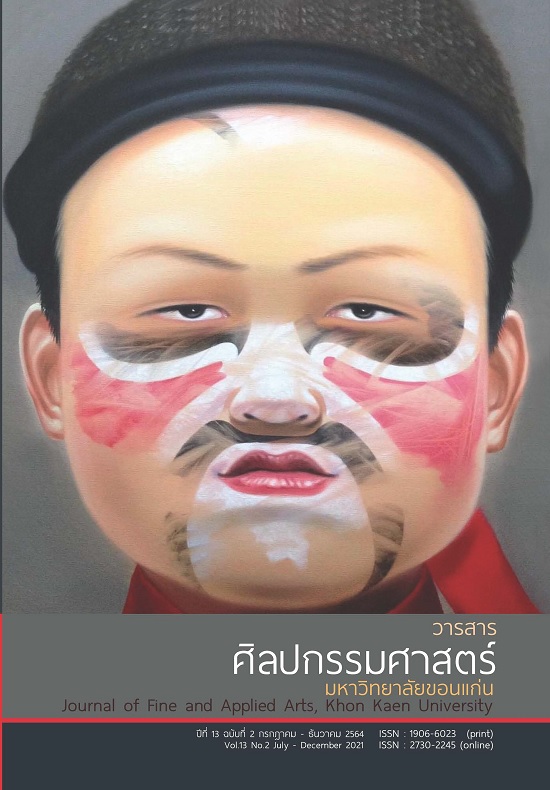"Eng Ko" : Colors Pattern To cre "Eng Ko" : Colors Pattern To creating paintings "Eng Ko" : Colors Pattern To creating paintings
Main Article Content
Abstract
The objective of this study was to study the background of "Eng Kor" of the Pu-Ya Shrine. Udon Thani Province To study the colors of the "Eng Kor" pattern, Chao Pu-Ya Shrine Udon Thani Province And to create paintings The tools used for data collection consisted of observational interviews. Researchers have used the theory of cultural diffusion. Concepts of cultural adaptation theory; And aesthetics theory To be used for analysis The study found that "Eng Kor" was first performed in Thailand around 1937-1942 by the Nakhon Sawan Shrine Committee. Which at the same time there was another group of "Eng Kor" in Phanat Nikhom district Chonburi Province, and later in the year 2488, the group "Enggor", Chao Pu-Ya Shrine. Udon Thani Province And considered to be the largest "Engo" group It has the most outstanding performances today. This is because it is a group that has been performing continuously for more than 60 years. Clothing Especially the performer makeup with colors and patterns that blend between old and modern styles. Techniques for using colors are bright, durable and have no side effects on performers. It is also a group that has a spectacular show with a spectacular rhythm of light and sound. In addition, the results of the study "Engko": Colors and Patterns to the Creation of Painting. Also made aware of the importance of activities That can make people in the city of Udon Thani have love Unity The medium is the acting culture "Eng Ko", which is now considered one of the province's unique performance culture. And is a great pride to the community, where the group "Eng Kor", Chao Pu-Ya Shrine Also received invitations to perform in various provinces On a regular basis In addition to promoting the ancient culture of the Chinese people It is also a dissemination of the concept that is connected with the concept of "Confucius" on gratitude, sacrifice and unity. To young people as well Therefore, this study is a major inspiration for the creative process of painting. Which focuses on the expression of beauty through the colors and patterns that appear on the face of the performer "Eng" in order to remind of the unique value that no matter how long time has passed, what has been accumulated from this ancestors will still Persist
Article Details
Content and information in articles published in the Journal of Fine and Applied Arts of Khon Kaen University is regarded as the opinion and sole responsibility of the author(s) directly; therefore, editors are not obliged to agree to or share any responsibility with regard to the content and information that appears within these articles.
All articles, information, content, image, etc. that have been published in the Journal of Fine and Applied Arts of Khon Kaen University is the copyright of the Journal of Fine and Appllied Arts of Khon Kaen University. Any person or organization who wishes to distribute all or parts of the articles for further dissemination or other usage must first receive permission from the Journal of Fine and Applied Arts of Khon Kaen University before proceeding to do so.
References
จิรวัฒน์ พิระสันต์. (2556). รายงานการวิจัยความสัมพันธ์ระหว่างศิลปะการแสดงเอ็งกอกับคววามหลายหลายทางชาติพันธุ์ จังหวัดนครสวรรค์. กรุงเทพฯ : สํานักงานคณะกรรมการวัฒนธรรมแห่งชาติ.
ถาวร สิกขโก. (2550). งิ้วหรืออุปรากรจีน อีกหนึ่งภาพสะท้อนทางวัฒนธรรมของชาวจีนกับชาวไทยที่มีมาเนิ่นนานนับตั้งแต่อดีตจนถึงปัจจุบัน. นครสวรรค์ : ก.ปั้นมณี.
ภิญโญ นิโรจน์. (2555). เล่าขานตรุษจีนปากน้ำโพ. นครสวรรค์ : สำนักงานศิลปวัฒนธรรม. มหาวิทยาลัย
ราชภัฏนครสวรรค์.
มาลินี ดิลกวาณิช. (2553). อุปรากรจีน (งิ้ว). กรุงเทพฯ : สถาบันเอเชียตะวันออกศึกษา.
สุชาดา พงศ์กิตติวิบูลย์. (2554). การสืบทอดสื่อพื้นบ้านเอ็งกอเพื่อเสริมสร้างอัตลักษณ์ของชุมชนชาวไทยเชื้อสายจีน อำเภอพนัสนิคม จังหวัดชลบุรี. ชลบุรี : ภาควิชานิเทศศาสตร์ มหาวิทยาลัยบูรพา.
สุชาติ แสงทอง และคณะ. (2559). 100 ปี วิถีปากน้ำโพ ประวัติศาสตร์ความเป็นมาของจังหวัดนครสวรรค์. ปัตตานี : สถาบันวัฒนธรรมศึกษากัลยาณิวัฒนา มหาวิทยาลัยสงขลานครินทร์ วิทยาเขตปัตตานี.
สุรชัย วิสุธากุล. (2559). ศตวรรษแห่งศรัทธาตรุษจีน 100 ปี สืบสารประเพณีแห่จ้าวพ่อ–จ้าวแม่ปากน้ำโพ.นครสวรรค์ : วิสุทธิ์การพิมพ์.
แสงอรุณ กนกพงศ์ชัย. (2550). วิถีจีน-ไทยในสังคมสยาม. กรุงเทพฯ : มติชน.


